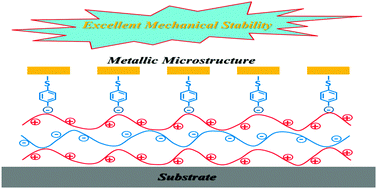Mechanical stabilization of metallic microstructures by insertion of an adhesive polymer underlayer for further optical and electrical applications†
Abstract
In this work a novel strategy to significantly improve the mechanical stability of metallic microstructures on substrates by inserting an adhesive polymer layer has been developed. The insertion was performed by a peel-assembly-transfer process. The microstructures were first peeled off from the prepared substrate and then transferred to the target substrate, between which the polymer layer was layer-by-layer (LBL) assembled on the interface sides of the microstructures and the substrates. The inserted polymer layer enhanced the adhesion between the metallic microstructures and the substrate without any visible damage to the morphology or significant deterioration with respect to functions. Besides, this strategy can be applied to a broad range of microstructures, such as isolated arrays, continuous films, and nanowire networks. The proposed peel-assembly-transfer strategy will pave the way to effectively improve the mechanical stability of metallic microstructures for practical applications.


 Please wait while we load your content...
Please wait while we load your content...